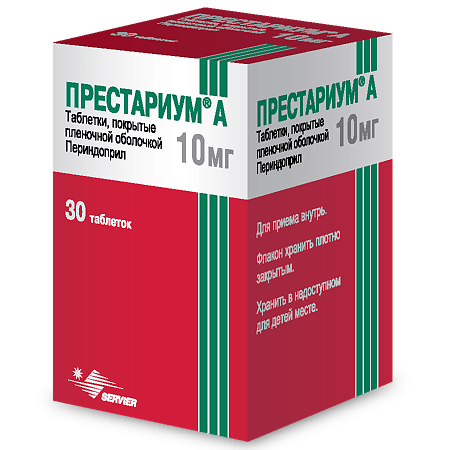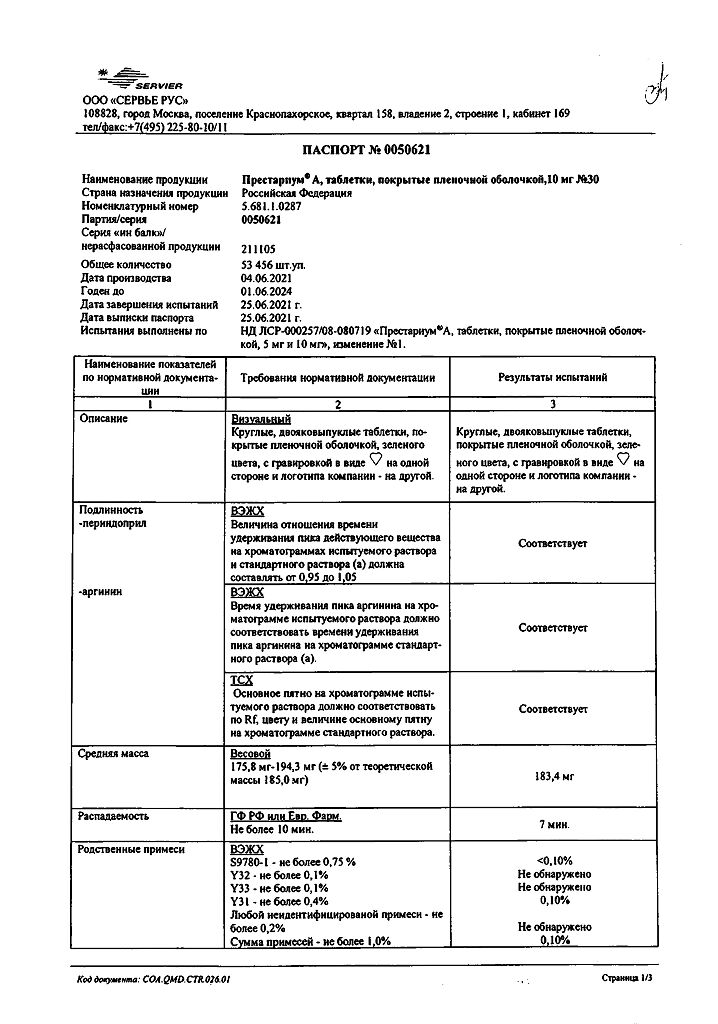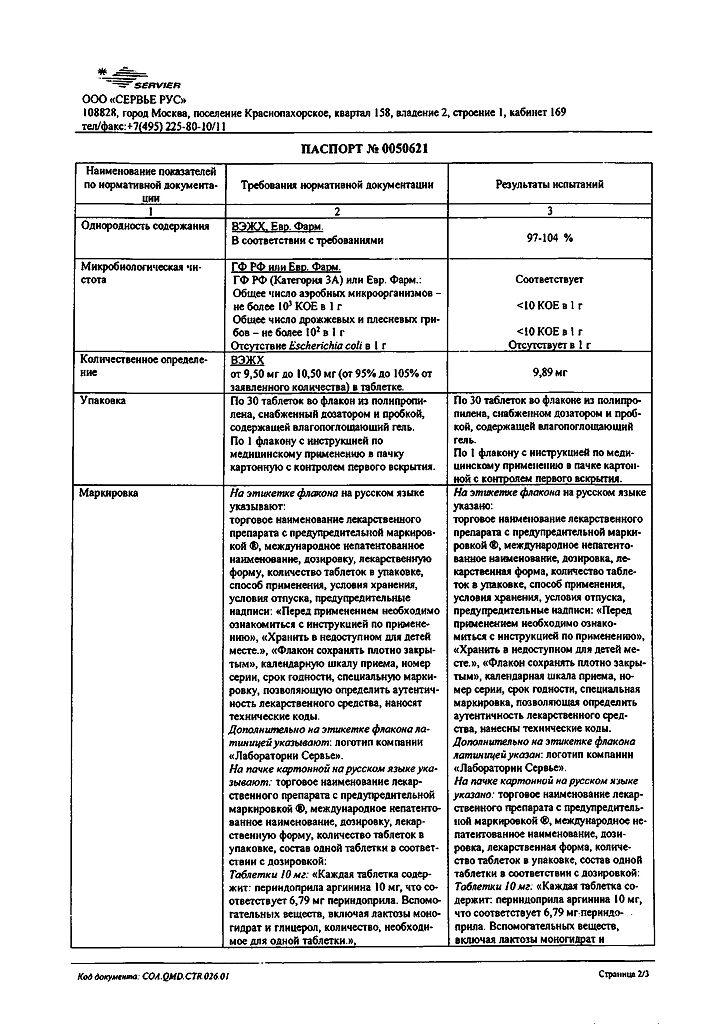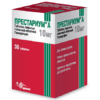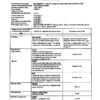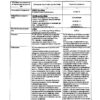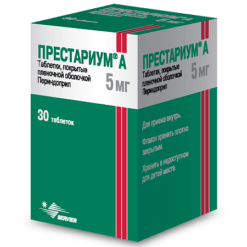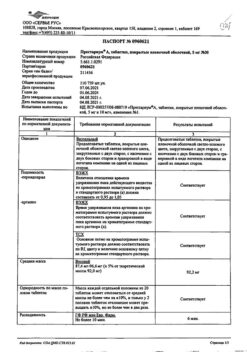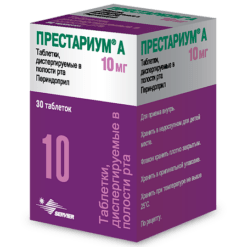No products in the cart.
Prestarium A, 10 mg 30 pcs
€13.97 €12.38
Description
Perindopril is an inhibitor of the enzyme that converts angiotensin I to angiotensin II (ACE inhibitor). ACE both converts angiotensin I into the vasoconstrictor angiotensin II and degrades bradykinin, which has a vasodilator effect, into an inactive heptapeptide. Perindopril reduces total peripheral vascular resistance, which leads to lower blood pressure, normalizes heart function by reducing preload and postload.
Indications
Indications
Arterial hypertension.
Chronic heart failure.
Prevention of recurrent stroke (combination therapy with indapamide) in patients who have suffered a stroke or transient ischemic cerebrovascular accident.
Stable coronary artery disease: reducing the risk of cardiovascular complications in patients with stable coronary artery disease.
Pharmacological effect
Pharmacological effect
Perindopril is an inhibitor of the enzyme that converts angiotensin I into angiotensin II (ACE inhibitor). ACE carries out both the conversion of angiotensin I into the vasoconstrictor substance angiotensin II, and the destruction of bradykinin, which has a vasodilator effect, into an inactive heptapeptide. Perindopril reduces total peripheral vascular resistance, which leads to a decrease in blood pressure, normalizes heart function, reducing preload and afterload.
Special instructions
Special instructions
Hypersensitivity/Angioedema: The drug should be discontinued and the patient should be observed until signs of edema have completely resolved. Angioedema, accompanied by laryngeal edema, can be fatal. Co-administration with the combination of valsartan + sacubitril (contraindicated; use of one drug no earlier than 36 hours after stopping the other), or with other neprilysin inhibitors (for example, racecadotril), or with mTOR inhibitors (for example, sirolimus, everolimus, temsirolimus), or with gliptins (linagliptin, saxagliptin, sitagliptin, Vildagliptin) – increases the risk of angioedema (eg, swelling of the tongue, vocal folds, or larynx with or without airway obstruction).
Anaphylactoid reactions during hemodialysis using high-flow membranes: prescribing an antihypertensive drug of a different class or using a different type of dialysis membrane.
Anaphylactoid reactions during low-density lipoprotein apheresis: In rare cases, life-threatening anaphylactoid reactions may occur. Temporarily discontinue ACE inhibitor therapy before each procedure.
Anaphylactoid reactions during desensitization: temporarily suspend ACE inhibitor therapy before each procedure. Similar reactions could develop again if treatment was accidentally or carelessly resumed.
Neutropenia/agranulocytosis/thrombocytopenia/anemia: use with extreme caution in patients with systemic connective tissue diseases while taking immunosuppressants, allopurinol or procainamide. Periodically monitor the level of leukocytes in the blood. Dual blockade of the RAAS: Concomitant use of ACE inhibitors, ARB II or aliskiren increases the risk of hypotension, hyperkalemia and decreased renal function (including acute renal failure). Double blockade of the RAAS is not recommended. The use of ACE inhibitors in combination with ARA II is contraindicated in patients with diabetic nephropathy.
Primary hyperaldosteronism: Taking drugs whose action is based on inhibition of the RAAS is not recommended: patients are not susceptible.
Pregnancy: Stop taking the drug and, if necessary, prescribe alternative therapy.
Hypotension: Careful monitoring at the beginning of therapy and when selecting a dose in patients with an increased risk of symptomatic arterial hypotension (with reduced blood volume, in patients with severe renin-dependent hypertension, symptomatic or severe heart failure) and in patients with coronary artery disease or cerebrovascular disease. Transient hypotension is not an obstacle to further use of the drug; after restoration of blood volume and blood pressure, therapy can be continued.
Mitral stenosis/aortic stenosis/hypertrophic cardiomyopathy: with caution.
Stable CAD: If unstable angina develops within the first month, the benefits and risks should be assessed before continuing therapy.
Renal dysfunction: control of creatinine and potassium. Treatment of patients with stenosis of the renal artery(s) or renovascular hypertension begins under close medical supervision using low doses of the drug and further adequate dose selection.
Impaired liver function: in rare cases, a syndrome of development of cholestatic jaundice with transition to fulminant liver necrosis, sometimes with death. If jaundice or a significant increase in liver enzymes occurs, stop taking the drug.
Ethnic differences: in the Negroid race, perindopril is less effective, and the risk of angioedema is higher.
Dry cough. Surgery/anesthesia: stop treatment one day before surgery.
Hyperkalemia: regular monitoring of potassium in the blood in renal failure, decreased renal function, age >70 years, diabetes mellitus, dehydration, acute heart failure, metabolic acidosis, concomitant use of potassium-sparing diuretics, potassium salts and aldosterone antagonists or ARA II.
Patients with diabetes: Monitor blood glucose during the first month of therapy. Kidney transplantation: no data available.
Renovascular hypertension: Increased risk of hypotension and renal failure in patients with bilateral renal artery stenosis or solitary renal artery stenosis. The use of diuretics may be a risk factor. Deterioration of renal function can occur with minor changes in serum creatinine concentrations, even in patients with unilateral renal artery stenosis.
Lactase deficiency, galactose intolerance, glucose-galactose malabsorption syndrome: should not be taken.
Phenylketonuria (for dispersible tablets): Should not be taken.
Control of vehicles and mechanisms. With caution, due to the risk of developing hypotension
Active ingredient
Active ingredient
Perindopril
Composition
Composition
Prestarium® A 5 mg, 10 mg: oral dispersible tablets containing 5 mg, 10 mg perindopril arginine. Prestarium® A 5 mg, 10 mg: film-coated tablets containing 5 mg, 10 mg perindopril arginine. Contains aspartame (dispersible tablets) and lactose as excipients.
Pregnancy
Pregnancy
Contraindicated.
Contraindications
Contraindications
Hypersensitivity to perindopril, or to any of the excipients, other ACE inhibitors;; history of angioedema (Quincke’s edema) associated with taking ACE inhibitors (see section Special instructions);
hereditary/idiopathic angioedema; pregnancy and lactation (see sections Special instructions and Pregnancy and lactation);
combined use with aliskiren and medicinal products containing aliskiren in patients with diabetes mellitus and/or moderate or severe renal impairment (glomerular filtration rate (GFR) <60 ml/min/1.73 m² body surface area) (see sections Interaction and Pharmacodynamic properties);
combined use with angiotensin II receptor antagonists (ARA II) in patients with diabetic nephropathy (see section Special instructions);
combined use with combination drugs containing valsartan + sacubitril (see sections Special instructions and Interactions);
extracorporeal therapy leading to contact of blood with negatively charged surfaces (see Interaction section);
severe bilateral stenosis of the renal arteries or stenosis of the artery of a single functioning kidney (see section Special instructions).
Side Effects
Side Effects
Common: dizziness, headache, paresthesia, vertigo, blurred vision, tinnitus, hypotension, cough, shortness of breath, abdominal pain, constipation, diarrhea, taste disorder (dysgeusia), dyspepsia, nausea, vomiting, itching, skin rash, muscle cramps, asthenia.
Uncommon: eosinophilia, hypoglycemia, hyperkalemia, hyponatremia, mood lability, sleep disturbance, drowsiness, syncope, palpitations, tachycardia, vasculitis, bronchospasm, dry mouth, urticaria, angioedema of the face, lips, extremities, mucous membranes, tongue, vocal folds and/or larynx, photosensitivity reactions, pemphigoid, increased sweating, arthralgia, myalgia, renal failure, erectile dysfunction, chest pain, malaise, peripheral edema, fever, increased concentrations of urea and creatinine in the blood, fall.
Rarely: exacerbation of psoriasis, increased activity of liver enzymes and bilirubin concentration in the blood.
Very rare: agranulocytosis or pancytopenia, decreased hemoglobin and hematocrit, leukopenia/neutropenia, hemolytic anemia in patients with congenital glucose-6-phosphate dehydrogenase deficiency, thrombocytopenia, confusion, angina pectoris, arrhythmia, myocardial infarction and stroke, eosinophilic pneumonia, rhinitis, pancreatitis, hepatitis (cholestatic or cytolytic), erythema multiforme, acute renal failure.
Frequency unknown: Raynaud’s syndrome. The development of syndrome of inappropriate antidiuretic hormone secretion (SIADH) has been reported when used together with other ACE inhibitors. SIADH can be considered a very rare possible complication associated with treatment with ACE inhibitors, including perindopril.
Interaction
Interaction
Contraindicated with: aliskiren (in patients with diabetes and/or renal impairment); ARA II in patients with diabetic nephropathy; extracorporeal therapy; combination of valsartan + sacubitril.
Not recommended with: aliskiren (in patients without diabetes or impaired renal function), ARA II, estramustine, potassium-sparing diuretics (triamterene, amiloride) or potassium salts, potassium-containing foods and nutritional supplements, lithium preparations.
With extreme caution: hypoglycemic agents (insulin, oral hypoglycemic agents, except gliptins), baclofen, non-potassium-sparing diuretics, potassium-sparing diuretics (eplerenone, spironolactone), nonsteroidal anti-inflammatory drugs (NSAIDs), including acetylsalicylic acid ≥ 3 g/day, racecadotril, mTOR inhibitors (eg, sirolimus, everolimus, temsirolimus), alteplase.
With some caution: antihypertensive drugs, vasodilators, gliptins (linagliptin, saxagliptin, sitagliptin, vildagliptin), tricyclic antidepressants, antipsychotics (neuroleptics) and general anesthesia, sympathomimetics, gold preparations.
Medicines that cause hyperkalemia: aliskiren, potassium salts, potassium-sparing diuretics, ACE inhibitors, ARB II, NSAIDs, heparins, immunosuppressants such as cyclosporine or tacrolimus, trimethoprim, sulfamethoxazole/trimethoprim (Co-trimoxazole).
Shelf life
Shelf life
3 years
Manufacturer
Manufacturer
Servier Rus LLC, Russia
Additional information
| Shelf life | 3 years |
|---|---|
| Manufacturer | Servier Rus LLC, Russia |
| Medication form | pills |
| Brand | Servier Rus LLC |
Other forms…
Related products
Buy Prestarium A, 10 mg 30 pcs with delivery to USA, UK, Europe and over 120 other countries.

